2006 BMW MOTORRAD K 1200 GT display
[x] Cancel search: displayPage 73 of 172

ing screw1in the direction
indicated by the H arrow.
If you want a softer damp-
ing characteristic, use a
screwdriver to turn adjust-
ing screw 1in the direction
indicated by the S arrow.
The adjusting screw can
be turned through three
and a half turns.
Rear suspension
damping, basic setting
Turn the adjusting screw
as far as it will go in the
direction indicated by the
H arrow and then turn it
back one and a half turns
in the direction indicated
by the S arrow. (One-up
85 kg)
Electronic Suspension
Adjustment ESA
OE
SettingsElectronic Suspension Ad-
justment ESA provides a con-
venient way of adapting the
motorcycle to different condi-
tions. Three spring preload
settings can be combined
with three damping charac-
teristics to fine-tune the mo-
torcycle's suspension to the
load it carries and the surface
over which you want to ride.
The damping characteristic is
shown in panel 1of the mul- tifunction display, and spring
preload in panel
2.
Call up settingsSwitch on the ignition.
Press button 1.
The current setting is dis-
played.
The reading remains visible
for a few seconds before
disappearing automatically.Adjust suspension
dampingSwitch on the ignition.
471zOperation
Page 74 of 172
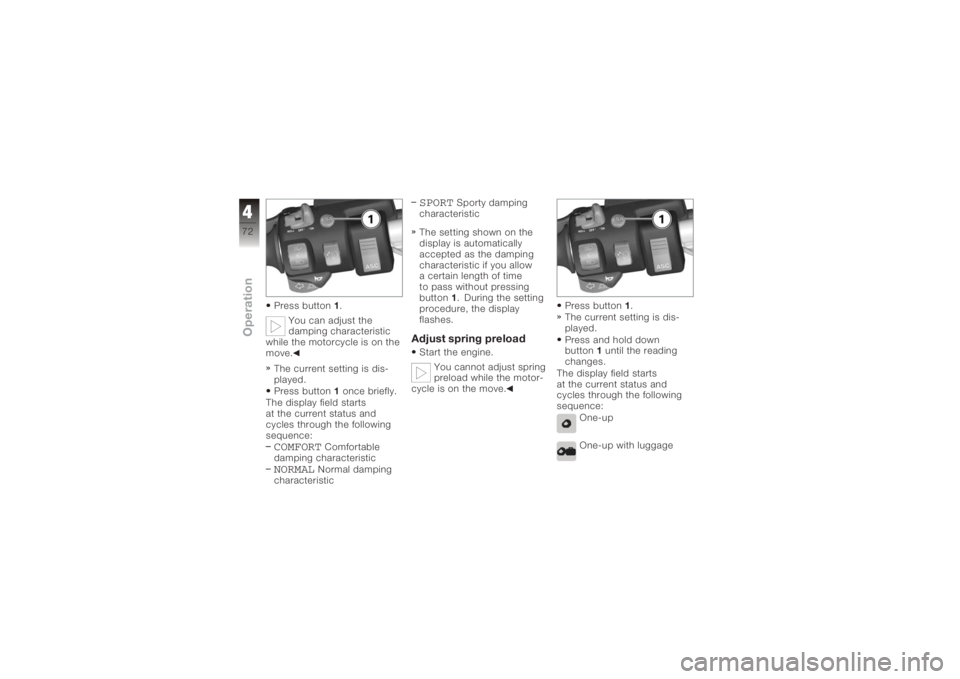
Press button1.
You can adjust the
damping characteristic
while the motorcycle is on the
move.
The current setting is dis-
played.
Press button 1once briefly.
The display field starts
at the current status and
cycles through the following
sequence:COMFORT
Comfortable
damping characteristic
NORMAL
Normal damping
characteristic
SPORT
Sporty damping
characteristic
The setting shown on the
display is automatically
accepted as the damping
characteristic if you allow
a certain length of time
to pass without pressing
button 1. During the setting
procedure, the display
flashes.
Adjust spring preloadStart the engine.
You cannot adjust spring
preload while the motor-
cycle is on the move. Press button
1.
The current setting is dis-
played.
Press and hold down
button 1until the reading
changes.
The display field starts
at the current status and
cycles through the following
sequence:
One-up
One-up with luggage
472zOperation
Page 75 of 172
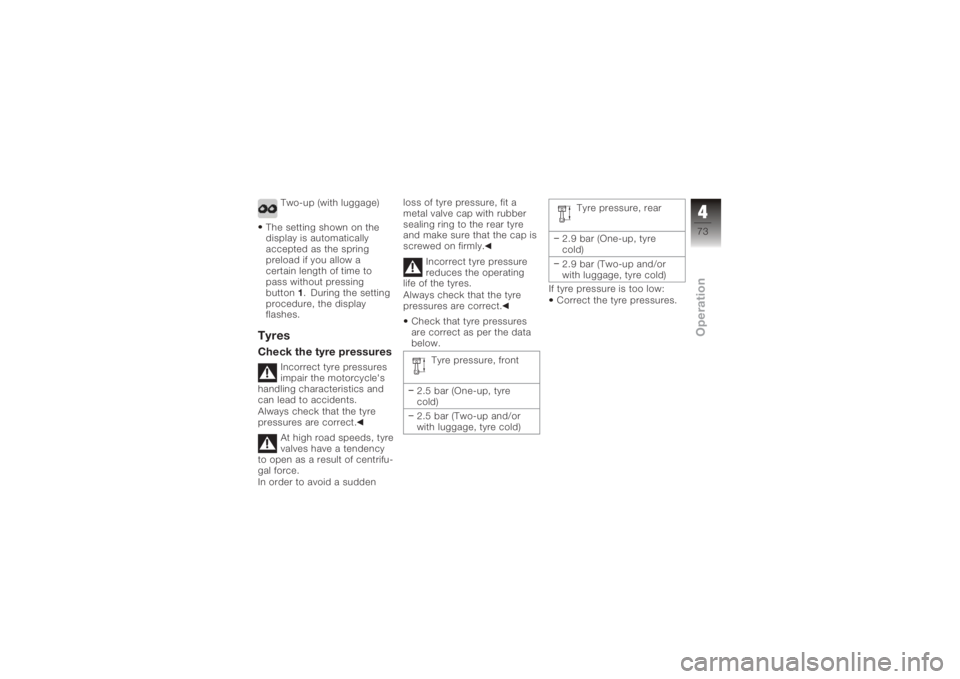
Two-up (with luggage)
The setting shown on the
display is automatically
accepted as the spring
preload if you allow a
certain length of time to
pass without pressing
button 1. During the setting
procedure, the display
flashes.
TyresCheck the tyre pressures
Incorrect tyre pressures
impair the motorcycle's
handling characteristics and
can lead to accidents.
Always check that the tyre
pressures are correct.
At high road speeds, tyre
valves have a tendency
to open as a result of centrifu-
gal force.
In order to avoid a sudden loss of tyre pressure, fit a
metal valve cap with rubber
sealing ring to the rear tyre
and make sure that the cap is
screwed on firmly.
Incorrect tyre pressure
reduces the operating
life of the tyres.
Always check that the tyre
pressures are correct.
Check that tyre pressures
are correct as per the data
below.
Tyre pressure, front
2.5 bar (One-up, tyre
cold)
2.5 bar (Two-up and/or
with luggage, tyre cold) Tyre pressure, rear
2.9 bar (One-up, tyre
cold)
2.9 bar (Two-up and/or
with luggage, tyre cold)
If tyre pressure is too low: Correct the tyre pressures.
473zOperation
Page 80 of 172
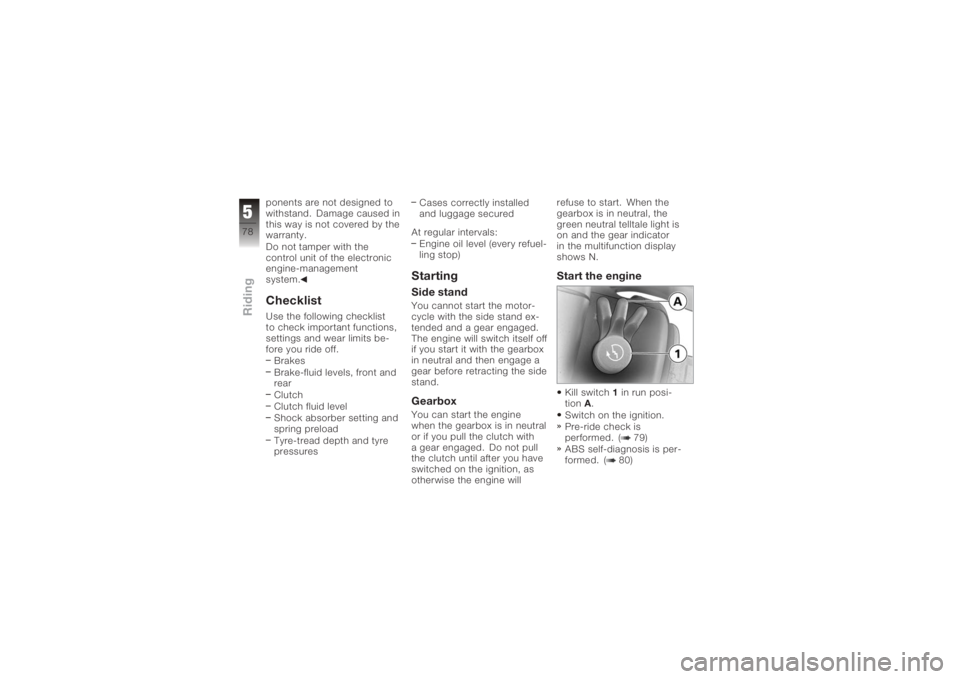
ponents are not designed to
withstand. Damage caused in
this way is not covered by the
warranty.
Do not tamper with the
control unit of the electronic
engine-management
system.ChecklistUse the following checklist
to check important functions,
settings and wear limits be-
fore you ride off.Brakes
Brake-fluid levels, front and
rear
Clutch
Clutch fluid level
Shock absorber setting and
spring preload
Tyre-tread depth and tyre
pressures Cases correctly installed
and luggage secured
At regular intervals: Engine oil level (every refuel-
ling stop)
StartingSide standYou cannot start the motor-
cycle with the side stand ex-
tended and a gear engaged.
The engine will switch itself off
if you start it with the gearbox
in neutral and then engage a
gear before retracting the side
stand.GearboxYou can start the engine
when the gearbox is in neutral
or if you pull the clutch with
a gear engaged. Do not pull
the clutch until after you have
switched on the ignition, as
otherwise the engine will refuse to start. When the
gearbox is in neutral, the
green neutral telltale light is
on and the gear indicator
in the multifunction display
shows N.
Start the engineKill switch
1in run posi-
tion A.
Switch on the ignition.
Pre-ride check is
performed. ( 79)
ABS self-diagnosis is per-
formed. ( 80)
578zRiding
Page 81 of 172
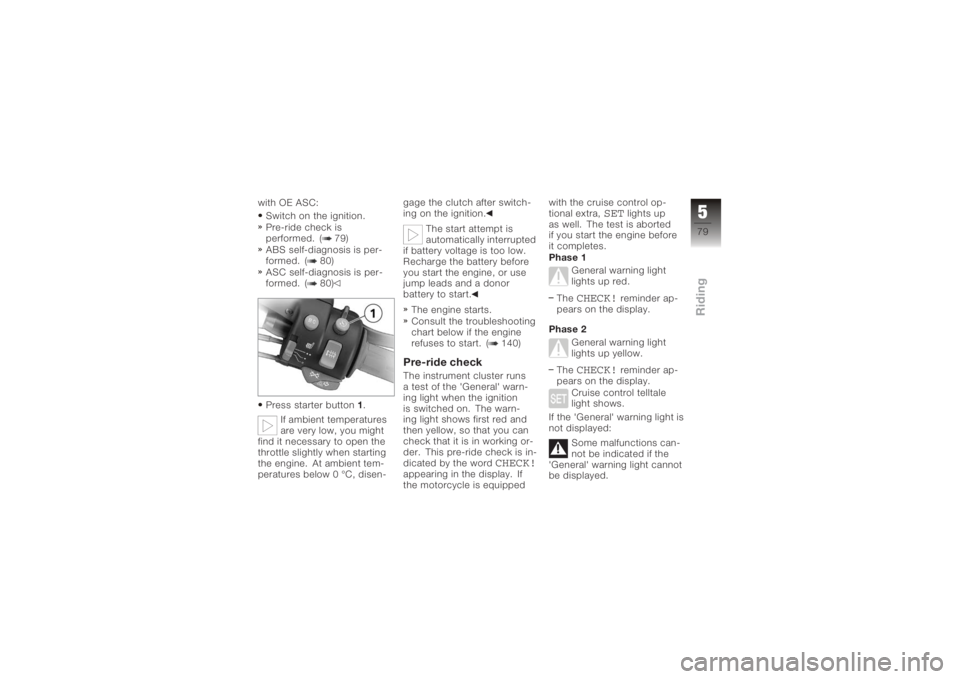
with OE ASC:Switch on the ignition.
Pre-ride check is
performed. ( 79)
ABS self-diagnosis is per-
formed. ( 80)
ASC self-diagnosis is per-
formed. ( 80)
Press starter button 1.
If ambient temperatures
are very low, you might
find it necessary to open the
throttle slightly when starting
the engine. At ambient tem-
peratures below 0 °C, disen- gage the clutch after switch-
ing on the ignition.
The start attempt is
automatically interrupted
if battery voltage is too low.
Recharge the battery before
you start the engine, or use
jump leads and a donor
battery to start.
The engine starts.
Consult the troubleshooting
chart below if the engine
refuses to start. ( 140)
Pre-ride checkThe instrument cluster runs
a test of the 'General' warn-
ing light when the ignition
is switched on. The warn-
ing light shows first red and
then yellow, so that you can
check that it is in working or-
der. This pre-ride check is in-
dicated by the word
CHECK!
appearing in the display. If
the motorcycle is equipped with the cruise control op-
tional extra,
SET
lights up
as well. The test is aborted
if you start the engine before
it completes.
Phase 1
General warning light
lights up red.
The
CHECK!
reminder ap-
pears on the display.
Phase 2 General warning light
lights up yellow.
The
CHECK!
reminder ap-
pears on the display.
Cruise control telltale
light shows.
If the 'General' warning light is
not displayed:
Some malfunctions can-
not be indicated if the
'General' warning light cannot
be displayed.
579zRiding
Page 87 of 172
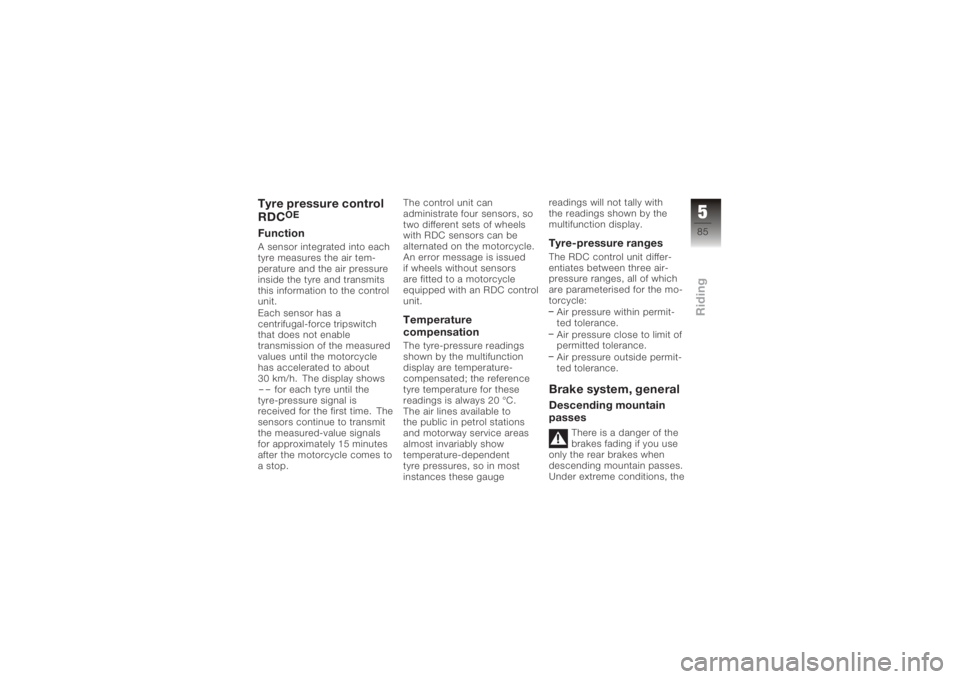
Tyre pressure control
RDC
OE
FunctionA sensor integrated into each
tyre measures the air tem-
perature and the air pressure
inside the tyre and transmits
this information to the control
unit.
Each sensor has a
centrifugal-force tripswitch
that does not enable
transmission of the measured
values until the motorcycle
has accelerated to about
30 km/h. The display shows--
for each tyre until the
tyre-pressure signal is
received for the first time. The
sensors continue to transmit
the measured-value signals
for approximately 15 minutes
after the motorcycle comes to
a stop. The control unit can
administrate four sensors, so
two different sets of wheels
with RDC sensors can be
alternated on the motorcycle.
An error message is issued
if wheels without sensors
are fitted to a motorcycle
equipped with an RDC control
unit.
Temperature
compensationThe tyre-pressure readings
shown by the multifunction
display are temperature-
compensated; the reference
tyre temperature for these
readings is always 20 °C.
The air lines available to
the public in petrol stations
and motorway service areas
almost invariably show
temperature-dependent
tyre pressures, so in most
instances these gaugereadings will not tally with
the readings shown by the
multifunction display.
Tyre-pressure rangesThe RDC control unit differ-
entiates between three air-
pressure ranges, all of which
are parameterised for the mo-
torcycle:
Air pressure within permit-
ted tolerance.
Air pressure close to limit of
permitted tolerance.
Air pressure outside permit-
ted tolerance.Brake system, generalDescending mountain
passes
There is a danger of the
brakes fading if you use
only the rear brakes when
descending mountain passes.
Under extreme conditions, the
585zRiding
Page 121 of 172
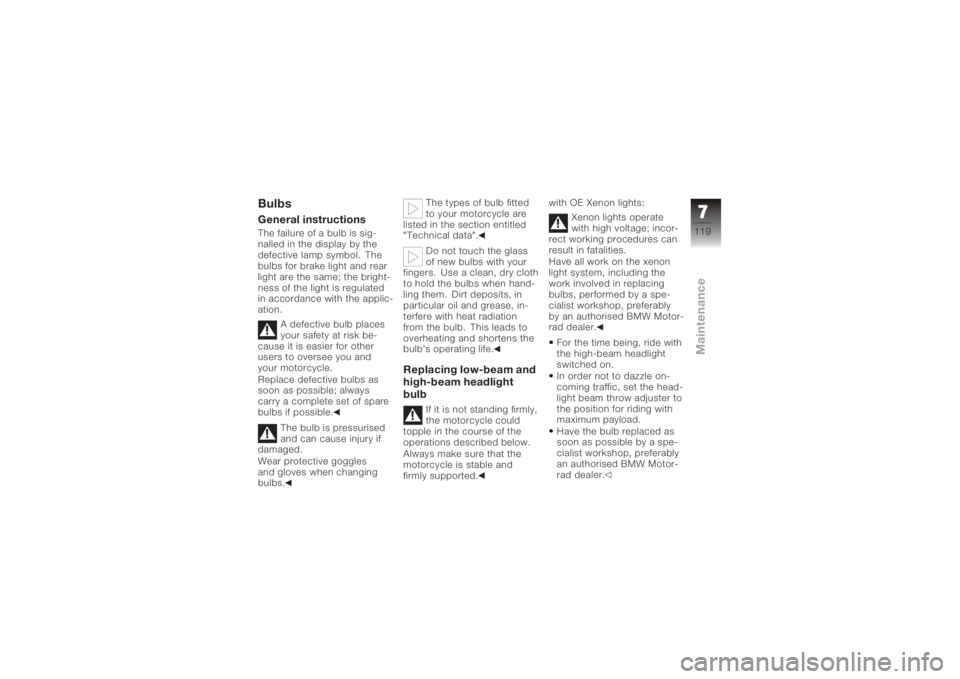
BulbsGeneral instructionsThe failure of a bulb is sig-
nalled in the display by the
defective lamp symbol. The
bulbs for brake light and rear
light are the same; the bright-
ness of the light is regulated
in accordance with the applic-
ation.A defective bulb places
your safety at risk be-
cause it is easier for other
users to oversee you and
your motorcycle.
Replace defective bulbs as
soon as possible; always
carry a complete set of spare
bulbs if possible.
The bulb is pressurised
and can cause injury if
damaged.
Wear protective goggles
and gloves when changing
bulbs. The types of bulb fitted
to your motorcycle are
listed in the section entitled
"Technical data".
Do not touch the glass
of new bulbs with your
fingers. Use a clean, dry cloth
to hold the bulbs when hand-
ling them. Dirt deposits, in
particular oil and grease, in-
terfere with heat radiation
from the bulb. This leads to
overheating and shortens the
bulb's operating life.
Replacing low-beam and
high-beam headlight
bulb
If it is not standing firmly,
the motorcycle could
topple in the course of the
operations described below.
Always make sure that the
motorcycle is stable and
firmly supported. with OE Xenon lights:
Xenon lights operate
with high voltage; incor-
rect working procedures can
result in fatalities.
Have all work on the xenon
light system, including the
work involved in replacing
bulbs, performed by a spe-
cialist workshop, preferably
by an authorised BMW Motor-
rad dealer.
For the time being, ride with
the high-beam headlight
switched on.
In order not to dazzle on-
coming traffic, set the head-
light beam throw adjuster to
the position for riding with
maximum payload.
Have the bulb replaced as
soon as possible by a spe-
cialist workshop, preferably
an authorised BMW Motor-
rad dealer.
7119zMaintenance
Page 131 of 172
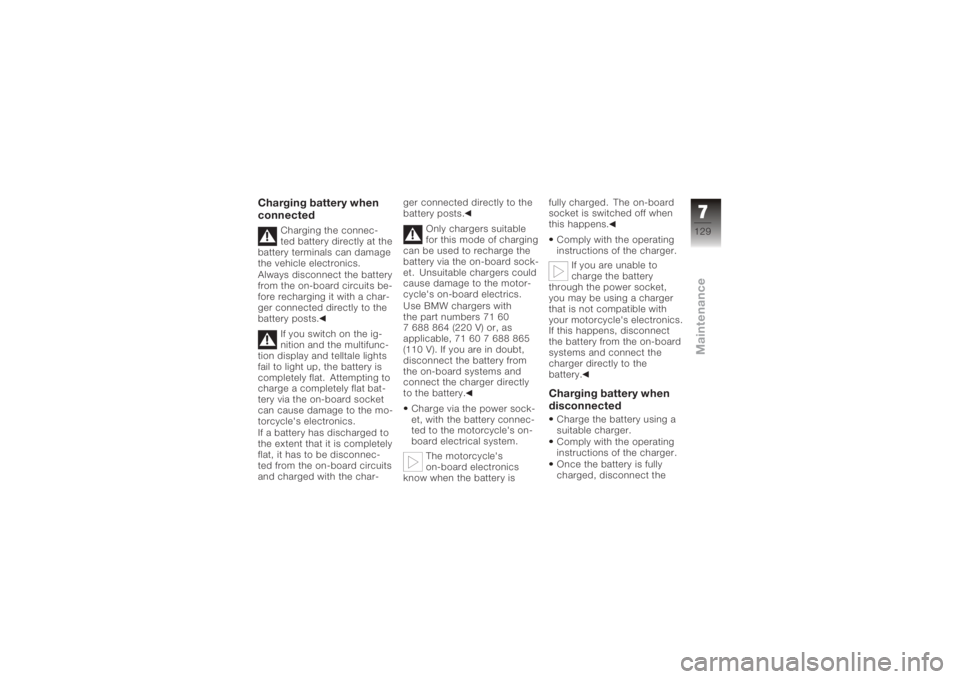
Charging battery when
connected
Charging the connec-
ted battery directly at the
battery terminals can damage
the vehicle electronics.
Always disconnect the battery
from the on-board circuits be-
fore recharging it with a char-
ger connected directly to the
battery posts.
If you switch on the ig-
nition and the multifunc-
tion display and telltale lights
fail to light up, the battery is
completely flat. Attempting to
charge a completely flat bat-
tery via the on-board socket
can cause damage to the mo-
torcycle's electronics.
If a battery has discharged to
the extent that it is completely
flat, it has to be disconnec-
ted from the on-board circuits
and charged with the char- ger connected directly to the
battery posts.
Only chargers suitable
for this mode of charging
can be used to recharge the
battery via the on-board sock-
et. Unsuitable chargers could
cause damage to the motor-
cycle's on-board electrics.
Use BMW chargers with
the part numbers 71 60
7 688 864 (220 V) or, as
applicable, 71 60 7 688 865
(110 V). If you are in doubt,
disconnect the battery from
the on-board systems and
connect the charger directly
to the battery.
Charge via the power sock-
et, with the battery connec-
ted to the motorcycle's on-
board electrical system. The motorcycle's
on-board electronics
know when the battery is fully charged. The on-board
socket is switched off when
this happens.
Comply with the operating
instructions of the charger. If you are unable to
charge the battery
through the power socket,
you may be using a charger
that is not compatible with
your motorcycle's electronics.
If this happens, disconnect
the battery from the on-board
systems and connect the
charger directly to the
battery.
Charging battery when
disconnectedCharge the battery using a
suitable charger.
Comply with the operating
instructions of the charger.
Once the battery is fully
charged, disconnect the
7129zMaintenance